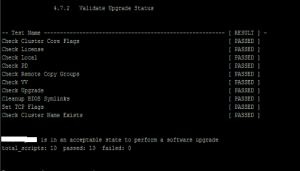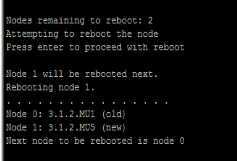As I went though the HP 3 Par Inform OS upgrade process I created a check list for quick reference of the things that need doing. I have shared it below, but please double check this list against the official HP documentation to ensure all points relevant to your environment and version you are upgrading to are covered.
Pre-Upgrade Checks
- Hosts
- Check compatibility of components. You can complete this step yourself by using SPOCK or send off a completed host worksheet to HP who will verify the compatibility for you. Items to checks for compatibility are: HBA model, HBA driver, HBA firmware if boot from SAN, MPIO driver, fabric switch firmware version. Depending on the results of the checks upgrade HBA, multipath and switch software as necessary
- Check MPIO set to round robin on Windows 2008 servers using the native MPIO driver. Process using psexec covered here under point 2
- LUN’s marked as offline following reboot – Apply KB2849097 to all connected Windows 2008 and 2012 hosts to stop this.
- There are also some hotfixes related to running ESX hosts VM’s with pass through or Iscsi LUN’s. KB275704 and KB2821052
2. SAN
- Load must be below 50% at the time of upgrade. Run statcpu and statport and check utilisation is below 50%
- Check current version is on upgrade path. showversion
- Check the system is healthy. checkhealth
Day of upgrade
- Load must be below 50% at the time of upgrade. Run statcpu and statport and check utilisation is below 50%
- If possible suspended tasks that would cause a heavy load eg backups
Stop AO, DO, and RC tasks before the upgrade. Plus stop anything else that interacts with:
- Suspend AO and other scheduled tasks setsched -suspend_all
- Stop system reporter. Stop windows service – 3Par System Reporter Sampler Service
- Showtask – and check for any DO activity
- Stop remote copy on both primary and DR site. stoprcopygroup [option] <group_name>,stoprcopy [options].
- Stop any software that directly interact with the SAN e.g. Recovery Manager, scripts etc.
- Check no one is logged in showuserconn
- Checkhealth again. checkhealth -svc detail performs a full health check on the system
- checkupgrade to verify if the system is ready to undergo an ONLINE upgrade.
- Check current connectivity status of the hosts showhost -pathsum
All upgrades until after 3.1.3 are performed by HP. If you would like to see more details on this step check here Part 3
Post Upgrade
- Check version is as expected showversion –a -b
- Verify connectivity of hosts showhost –pathsum, plus check monitoring software attached hosts etc. for any potential issues
- Restart suspended tasks setsched -resume_all . Check schedules running again showsched
- Restart system reporter windows service (3Par System Reporter Sampler Service) plus any other software you stopped such as Recovery Manager
- Resume backups and any other systems you suspended to reduce the load on the SAN
- Restart Remote Copy
- Check for new CLI and management console from FTP supplied by HP or software depot. Check compatibility in SPOCK
- Plus if you use any other 3Par software such as Recovery manager VSS provider etc check in the release notes for the latest version and then download via supplied FTP link from HP or from the software depot
- Remove default CPG. removecpg
Catch the full series of posts in which I ran through the upgrade process in detail, Part 1, Part 2, Part 3




